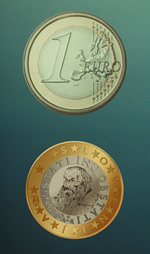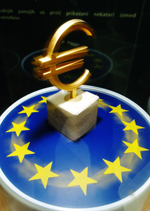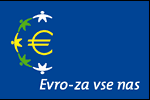En Route to the Adoption of the Euro
By becoming an EU member on 1 May 2004, Slovenia committed itself to the adoption of the common European currency, the euro. Even though this obligation is part of the accession agreement, the country first had to meet the convergence criteria, which has been one of the key objectives of business and monetary policies. Now, two years after joining the EU, Slovenia has almost reached this goal. It is expected that the country will adopt the euro on 1 January 2007, the first of the new member states to do so.
EU membership has certainly had a major influence on international trade, and monetary and fiscal policies. Slovenia's entry into the EU and the Exchange Rate Mechanism (ERM II) meant that the country needed to change its exchange rate regime. Inflation, which constantly hovered above the EU average before the accession, has dropped considerably. Interest rates have also fallen. The EU also importantly influenced our fiscal policy: Slovenia started contributing to the EU budget, while it also became a beneficiary, receiving considerably larger funds from the EU than before accession. Consequently, budget planning had to be changed.
The last criterion that Slovenia has met is price stability, which meant that inflation needed to be lowered. This was a result of successful coordination of all economic actors, who introduced the necessary measures for a gradual and sustainable reduction of inflation since mid-2001. The decisive factors included a restrictive fiscal policy, stable exchange rate, low general government gross debt, the agreement reached by social partners, which kept the wage rises below productivity growth, and a wise policy of administered prices. Another important factor was a broad consensus: the entire society, particularly the business sector, trusted that the objective of adopting the euro was attainable.
Why the Euro?
When the common European currency was introduced in non-physical form in the first eleven member states (later followed by Greece), the EU members still had the possibility to opt out of the single currency. The new EU member states, including Slovenia, do not have this right. They must all pursue economic and monetary policies in a way that will enable them to meet convergence criteria, and thus prepare for the adoption of the euro. Of course, there is much more to the adoption of the euro than formal compliance with legal provisions.

From the economic point of view, adoption of the euro makes sense: we are a small and extremely open economy, and given the current conditions, a stable exchange rate is essential for our economy. Our economic cycle is to a great extent synchronised with movements in the Eurozone markets, and external factors influence Slovenia in much the same way as Eurozone members. This is the reasoning behind the decision to enter the ERM II early, and we are guided by the same way of thinking regarding our entry into the Eurozone.
In November 2005, Slovenia met all the Maastricht criteria, and it continues to meet them in 2006. Therefore, in March this year, the government and the central bank decided to ask the European Commission (EC) and the European Central Bank (ECB) to assess our readiness for entering the Eurozone.
In addition to economic convergence, legal convergence is also a prerequisite for the introduction of the euro in the Republic of Slovenia. The adoption of the euro is regulated by European legislation, which has to be transposed to a national level, and modified accordingly.
Slovenia is well prepared for the adoption of the common European currency. This is also due to the Act on double pricing in tolars and euros, under which institutions are required to display prices in both currencies in the period from 1 March 2006 until 30 June 2007. An agreement has been reached on cooperation in monitoring prices following the introduction of the euro.
Procedure preceding the adoption of the common European currency
The EC the ECB have issued so-called convergence reports. Both reports comprehensively assess whether Slovenia has fulfilled all the conditions for the adoption of the euro - stability of prices, fiscal stability, and the stability of the exchange rate, the convergence of interest rates, and legal harmonisation. In these reports the EC and the ECB confirmed that Slovenia had met the criteria for the adoption of the euro. On 1 January 2007, Slovenia will become the first new member state to do so, and the thirteenth Eurozone member.

Photo: Nebojša Tejić
The political decision on the enlargement of the Eurozone was taken at the EU Summit on 15 and 16 June 2006 in Brussels, while legal basis for the accession to the elite economic and monetary union was adopted at the ECOFIN meeting on 11 July 2006. An irrevocable exchange rate between the tolar and the euro was set, which is SIT 239.640 for 1 euro.
Technical preparations for the adoption of the euro are the responsibility of the Coordinating Committee for Technical Preparations for the Introduction of the Euro, co-headed by the Ministry of Finance and the Bank of Slovenia. Within the committee a working group for communications has been set up. Its members include representatives of the Government of the Republic of Slovenia (Office of the President of the Government of the Republic of Slovenia, Government Public Relations and Media Office, Ministry of Finance, Ministry of the Economy), the Statistical Office of the Republic of Slovenia, the Bank of Slovenia, the Bank Association of Slovenia, the Chamber of Commerce and Industry of Slovenia, the Chamber of Craft of Slovenia, and the Slovene Consumers' Association. The working group has also prepared a strategy on which the campaign has been based. The strategy was approved in the spring of 2005 by the Governing Board of the Bank of Slovenia and the Government of the Republic of Slovenia.
Introduction of the euro in Slovenia (website of the Bank of Slovenia)

